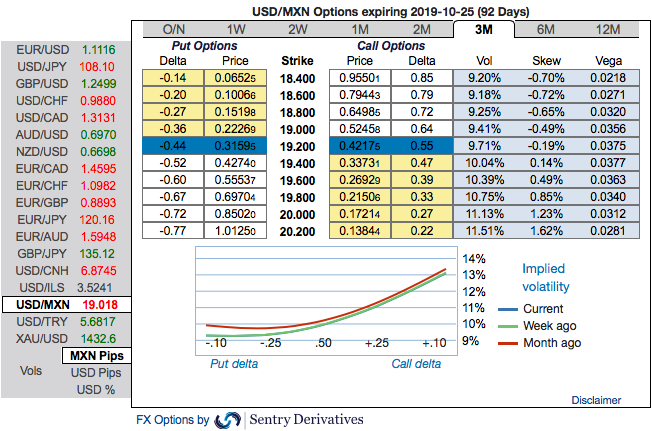Speculations about early rate cuts in Mexico are increasing: As price data published yesterday showed, inflation continues to decline. In early July it fell to the lowest level in the past two years. That puts inflation at the upper end of the range but within the Banxico's inflation target of 2-4%.
At the same time, growth leaves much to be desired: Seasonally adjusted GDP shrank by 0.2% in the first quarter of 2019, and the second quarter should not have been too excitingly either - the preliminary GDP data scheduled for next week will provide more clarity in this respect.
In view of the gloomy growth outlook, forecasts for the current year are being lowered in many places: This week, the IMF revised its - admittedly so far quite optimistic - outlook and now expects a growth rate of 0.9%, just as we do.
All in all, good inflation data and weak growth numbers increase the chance that Banxico will start lowering key rates by the end of the year as we expect. For the MXN, this will probably mean somewhat weaker levels in the future.
We, therefore, do not reckon the current levels sliding below 18.75 in USDMXN to be sustainable, while the major uptrend remains robust.
OTC updates: Of late, MXN seemed to be extending recovery threatening upper bound of the recent range. Please be noted that the 3m USDMXN implied volatility skews signal continued upside risks, bids for OTM call strikes up to 20.20 levels. The previous massive sell-off of Mexican peso caused a vol surface dislocation, nudging skews to the highest since the 2016 US Presidential elections. Delta hedged 1*1.5 ratio call spreads exploit the dislocation while also having historically offered a superb performance. +1Y/-3M calendars of risk reversals take advantage of the lagging back-end vs front-end implied skews. Courtesy: Commerzbank & Sentry



 Trump’s "Shock and Awe" Agenda: Executive Orders from Day One
Trump’s "Shock and Awe" Agenda: Executive Orders from Day One  BoE Set to Cut Rates as UK Inflation Slows, but Further Easing Likely Limited
BoE Set to Cut Rates as UK Inflation Slows, but Further Easing Likely Limited  U.S. Stocks vs. Bonds: Are Diverging Valuations Signaling a Shift?
U.S. Stocks vs. Bonds: Are Diverging Valuations Signaling a Shift?  South Korea Warns Weak Won Could Push Inflation Higher in 2025
South Korea Warns Weak Won Could Push Inflation Higher in 2025  BOJ Expected to Deliver December Rate Hike as Economists See Borrowing Costs Rising Through 2025
BOJ Expected to Deliver December Rate Hike as Economists See Borrowing Costs Rising Through 2025  Canada Stocks Steady as Markets Await Fed and BoC Decisions
Canada Stocks Steady as Markets Await Fed and BoC Decisions  Fed Meeting Sparks Division as Markets Brace for Possible Rate Cut
Fed Meeting Sparks Division as Markets Brace for Possible Rate Cut  US Gas Market Poised for Supercycle: Bernstein Analysts
US Gas Market Poised for Supercycle: Bernstein Analysts  Indonesia Surprises Markets with Interest Rate Cut Amid Currency Pressure
Indonesia Surprises Markets with Interest Rate Cut Amid Currency Pressure  ECB Signals Steady Rates Ahead as Policymakers Warn of Inflation Risks
ECB Signals Steady Rates Ahead as Policymakers Warn of Inflation Risks  Oil Prices Dip Slightly Amid Focus on Russian Sanctions and U.S. Inflation Data
Oil Prices Dip Slightly Amid Focus on Russian Sanctions and U.S. Inflation Data  S&P 500 Relies on Tech for Growth in Q4 2024, Says Barclays
S&P 500 Relies on Tech for Growth in Q4 2024, Says Barclays 

























